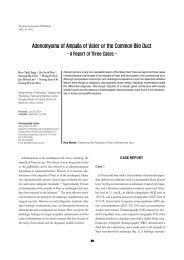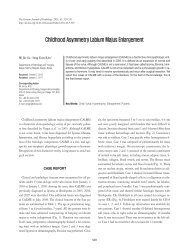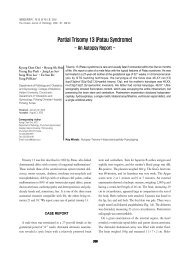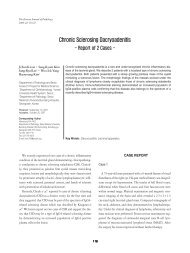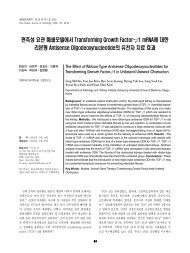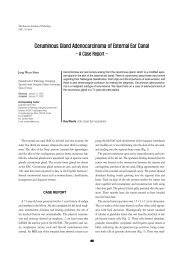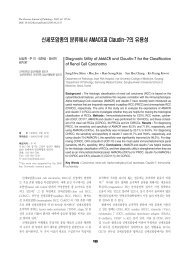Digoxigeninì ë¶ì°©ìí¨ RNA in situ Hybridizationì ê°ì ë ì°êµ¬ ë°©ë²
Digoxigeninì ë¶ì°©ìí¨ RNA in situ Hybridizationì ê°ì ë ì°êµ¬ ë°©ë²
Digoxigeninì ë¶ì°©ìí¨ RNA in situ Hybridizationì ê°ì ë ì°êµ¬ ë°©ë²
You also want an ePaper? Increase the reach of your titles
YUMPU automatically turns print PDFs into web optimized ePapers that Google loves.
Digoxigen<strong>in</strong> labeled <strong>in</strong> <strong>situ</strong> hybridization 105<br />
SF<br />
Tissue array: stomach carc<strong>in</strong>oma<br />
A<br />
B<br />
D<br />
C<br />
D<br />
E<br />
F<br />
G<br />
H I J<br />
Fig. 2. <strong>RNA</strong> <strong>in</strong> <strong>situ</strong> hyrbidization, A-D; expression of elaf<strong>in</strong> m<strong>RNA</strong>, A; tissue array slide composited with the cases of stomach carc<strong>in</strong>oma,<br />
*; absent of specimen due to technical failure (× 3), most of cases are <strong>in</strong>tensely positive, B; low magnification of a positive case of tissue<br />
array. Tumor cells (arrows) and stromal fibrous (SF) tissue are dist<strong>in</strong>guishable (× 25), C; human adult submandibular gland fixed <strong>in</strong> 4%<br />
paraformaldehyde and prepared <strong>in</strong> RNase protection procedure, show<strong>in</strong>g <strong>in</strong>tense positive reaction <strong>in</strong> the ac<strong>in</strong>ar cells (arrows) and ductal<br />
cells (D) (× 400), D; high magnification of panel b, elaf<strong>in</strong> m<strong>RNA</strong> is <strong>in</strong>tensely positive <strong>in</strong> the <strong>in</strong>filtrat<strong>in</strong>g tumor cells (arrows) (×400), E-F;<br />
expression of snailfish clone (C90-171) (× 400), E; too <strong>in</strong>tense positive reaction <strong>in</strong> the stromal fibrous tissue (arrows) when RNase A<br />
treatment was omitted, F; nonspecific positive reaction was removed by RNase A treatment, G; expression of VEGF (vascular endothelial<br />
growth factor) m<strong>RNA</strong> became very weak after RNase A treatment (× 400) H; double immunohistochemical sta<strong>in</strong><strong>in</strong>g of lam<strong>in</strong><strong>in</strong><br />
(arrows) and GFAP (glial fibrillary acid prote<strong>in</strong>, arrowhead) I; <strong>in</strong> <strong>situ</strong> hybridization of lam<strong>in</strong><strong>in</strong> -cha<strong>in</strong> followed by immunohistochemical<br />
sta<strong>in</strong><strong>in</strong>g of GFAP (× 400), J; negative control of <strong>RNA</strong> <strong>in</strong> <strong>situ</strong> hybridization us<strong>in</strong>g universal sense <strong>RNA</strong> probe of elaf<strong>in</strong> sense probe.



